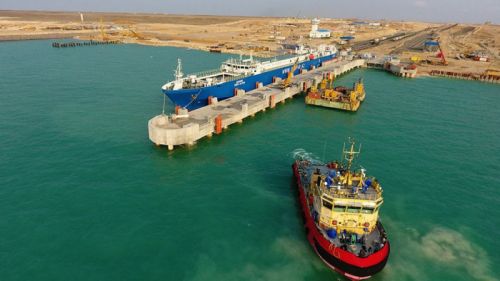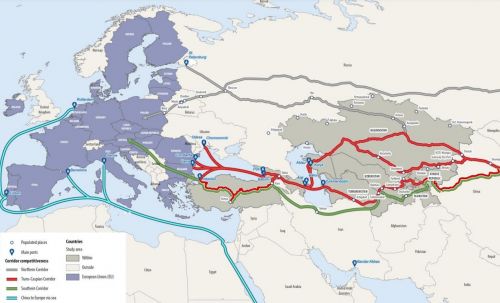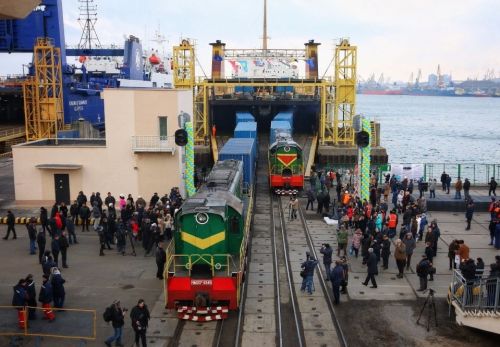The attacks on commercial shipping in the Red Sea by the Yemeni Houthis for more than five months have seriously disrupted the operation of one of the world's largest trade routes. Red Sea shipping has yet to be paralyzed completely, but most shipowners now prefer the route around Africa. The latter is longer, and, as a result, the cost of delivering cargo is rising. Freight rates on this route have at least doubled. This is forcing cargo owners to consider other logistics options, including overland routes.
For example, it was recently announced that work is underway on a land corridor to transport goods from the Persian Gulf through the United Arab Emirates, Saudi Arabia, and Jordan to Israeli ports for onward shipment to Europe. Goods from India, Thailand, South Korea, and China are already being shipped this way. Of course, these are insignificant volumes, and this option is considered temporary.
Rail transit through Eurasia remains the main alternative for transporting containerized cargo from China to the European Union.
Transit through Russia: the pendulum is swinging upwards
Before Russia's open attack on Ukraine, shippers on this route actively used container trains transiting through Russia and Belarus. The route is more expensive than the sea route but faster.
International sanctions prohibit some cargo, but these sanctions primarily apply to dual-use goods. In addition, while cargo transportation by road to/from Russia and Belarus is effectively banned, there is no ban on cargo transportation rail. Therefore, China-EU transit trains continue to pass through the territory of Russia. The Europeans themselves have recently confirmed this.
For example, Carsten Hinne, a member of the executive board of the Port of Duisburg, said in comments to the CFTS portal in late 2022, "The route is a ‘classic’ one: from China in transit through Kazakhstan, Russia, Belarus, and Poland to Germany. Most rail freight traffic between Asia and Europe still goes through this corridor."
Nevertheless, shippers have redirected some cargo "to be on the safe side" or because of their principled position on the war in Ukraine. Some logistics companies have also deliberately abandoned the "toxic" route.
As a result, the volume of rail container transportation on this route decreased after the beginning of the Russian invasion of Ukraine. For example, data show that container transportation from China to the European Union on this route through Russia decreased by 48.2% to 143,284 twenty-foot equivalent units (TEUs) of containers in 2023. Of these, 117,628 TEUs went to Poland (down 34.1%) and 12,866 TEUs to Germany (down 80%). Container traffic in the opposite direction will decrease by 49.4% to 67,826 TEUs, including 58,282 TEUs from Germany.
Now, the situation is changing, and the Russians are rubbing their hands: the crisis in the Red Sea has facilitated an increase in the volume of container transit from China to the European Union. According to the Russian Railways, container transit from China to the European Union increased by 44% to 90,000 TEUs in the first quarter of 2024.
What is happening is a recovery of container transit volumes from China, rather than an increase in the transportation of goods in the opposite direction. The Russians have compensated for the loss of cargo from the European Union with their exports and goods from Belarus. "If before we transported a lot of cargo from the European Union to China, now we deliver more cargo from friendly countries," Alexei Shilo, deputy general director of the Russian Railways, said recently.
Speaking of Belarus, the Community of Belarusian Railroaders, which opposes the government of President Alexander Lukashenko, claims that the volume of container transit through Belarus will decrease by 32% in 2022 and by 54% in 2023. In March, the administrators of the Community of Belarusian Railroaders said that the Belarusian authorities' hopes for a recovery in transit volumes amid the problems in the Red Sea seemed too optimistic. According to them, there was an increase, but it was insignificant. "Although some logistics projects or companies have seen some increase in container transit, this is insignificant and does not translate into an overall noticeable increase," the community said.
Western logistics companies and railway operators, however, say that demand for the transportation of goods from Asia to Europe by rail through Russia has already increased. For example, Germany's DHL told the Financial Times newspaper that requests to transport goods on the Russian rail corridor had risen by about 40% since container ships began diverting via a longer route in December, while RailGate Europe company said demand was up 25-35%.
According to the newspaper, container rail movements from China to Poland amounted to 14,532 TEUs in January. "While the figure was 36% higher than in January 2023, it would not fill one of the largest modern container ships, which carry 24,000 TEUs each," the Financial Times wrote.
Nevertheless, the Russians are pleased with the trend and expect the volume of container traffic through Russia to the European Union on this route to increase even more because of the increase in the cost of shipping on the Red Sea and Suez Canal. They also hope that European shippers will also use it in the current circumstances. This would also be politically good for the aggressor country against the backdrop of international sanctions.
To emphasize that there is no alternative to the route through Russian territory, in March the Russian media eagerly "amplified" an article in the British newspaper The Standard, which argued that the attacks on ships in the Red Sea could inspire a wave of piracy to spread, to which Britain would be particularly susceptible because three of the major choke points - the Faroes Gap, the Strait of Denmark, and the Strait of Dover in the English Channel - are on its doorstep. In addition, the article says that with the onset of global warming, the High Arctic has become the new arena of maritime choke points. It notes that the use of drones could disrupt key logistics routes off the coast of Europe. However, the article did not identify the forces that might pose such threats in the aforementioned waters. It is worth noting here that the majority owner of The Standard is a Russian, Alexander Lebedev, who is under Canadian and Ukrainian sanctions for supporting Russian aggression and doing business in annexed Crimea. Therefore, it is unnecessary to comment on the motives behind such articles.
Bypassing the aggressor: growing interest
An alternative to the Russian transit route runs through Central Asia, the Caucasus, and Turkey. Traditionally, this route has been less attractive because part of it requires ferries to cross the Caspian and Black seas.
In the past, the industry has complained that the Trans-Caspian International Transport Route (TITR, also known as the Middle Corridor) lacked the infrastructure to handle the required cargo volumes. This is particularly true of the infrastructure on the Caspian Sea. However, the countries through which these cargoes pass, European governments, and the Chinese government are interested in developing an alternative route.
"Kazakhstan has announced plans to invest more into its ports along the Caspian Sea and its state-run railway operator Kazakhstan Temir Zholy reported that terminals along its western coast have already doubled their shipping volume. Chinese officials have also moved to simplify transport, with Wang Lingjun, deputy minister of China’s General Administration of Customs, saying on May 25 that Beijing is improving its customs procedures at the Alashankou and Khorgos land ports on its border with Kazakhstan which would lead to increased volumes of goods being sent by rail," according to a report published in the fall of 2022.
"Our new data confirms that the Middle Corridor is not only viable but can also become essential to the economies of countries along the route," Antonella Bassani, the World Bank’s vice president for Europe and Central Asia, said a year later. According to her, Azerbaijan, Georgia, and Kazakhstan, along with other countries, "have made significant progress in aligning their vision and moving this corridor forward" and the World Bank is committed to supporting the Middle Corridor in partnership with the governments along the route and other multilateral organizations.
Kazakhstan’s Deputy Minister of Transport Satzhan Ablaliyev said that the TITR has increased its capacity since the beginning of the war in Ukraine. According to him, the volume of traffic on the route increased by 65% in 2023 and the volume of cargo transportation increased by 2.5 times in January 2024, compared with last year. "This year, we plan to increase the volume by 43% to reach 4.2 million tons," he said.
"In the last year, we have actually done a lot. The discussions have been very intense and very productive. The discussions have been very intense and very productive," said Henrik Hololei, Hors Classe Adviser at the European Commission’s Directorate-General for International Partnerships, during a visit to Kazakhstan.
Hololei added that the European Union has held talks with each Central Asian state, especially Kazakhstan, as the corridor passes through a significant part of its territory. According to him, the next step will be the establishment of a permanent coordinating platform to oversee the implementation of the projects.
According to logistics experts, the interest in this route is not lower than the interest in the shorter corridor through Russia. "Since January, the number of inquiries has soared more than tenfold, and the actual export volume of goods has increased by three to four times," Kong Weidong, head of the Zhengzhou branch of T.H.I. Group (Shanghai) Ltd., a freight forwarder, told the China Daily newspaper.
China Railway International Multimodal Transportation (CRIMT), which is the national operator of China-Europe freight trains and a subsidiary of China Railway Container Transport, has also reported a significant increase in inquiries about the China-Europe freight train service since the beginning of this year.
Kang Yingfeng, deputy general manager of China Railway International Multimodal Transportation, said that Chinese, European, and American customers, as well as major international logistics companies such as DHL and Kuehne+Nagel, have shown strong interest in the new route.
As for the European Union, it was announced at the Global Gateway Investors Forum for EU-Central Asia Transport Connectivity in early 2024 that European and international financial institutions would commit EUR 10 billion in support and investments for sustainable transport connectivity in Central Asia as an alternative to the route through Russia. According to the announcement, the Investors Forum builds on the findings of the June 2023 study on "Sustainable Transport Connections between Europe and Central Asia," which was conducted against the backdrop of Russia's invasion of Ukraine to identify the transport infrastructure needs that would significantly improve the operational efficiency and economic attractiveness of the trans-Caspian transport networks. In particular, the study assessed the infrastructure investment needs of Kazakhstan, Kyrgyzstan, Tajikistan, Turkmenistan, and Uzbekistan.
Although Ukrainian ports are on the map of the Trans-Caspian route published in the European Commission's document, the extension of this route to the west - either by land through Turkey or through the Black Sea to the ports of Romania and Bulgaria - is being considered.
Ukraine (not) on the sidelines of the Trans-Caspian route
Although the alternative transit route has considerable potential (despite the aforementioned bottlenecks), Ukraine's involvement in the project has been too sluggish.
For example, in 2015, the Ukrainian Ministry of Infrastructure issued an order to transfer the ferries "Heroes of Plevna" and "Heroes of Shipka" onto the books of the Liski Transport Service Center, a branch of the Ukrainian Railways joint-stock company (Ukrzaliznytsia). Ukrzaliznytsia planned to use these ferries on the Varna - Batumi - Varna ferry line to transport container trains operating on the New Silk Road. The Ukrferry shipping company was the operator of the ferries before the transfer, and the company's president, Oleksandr Kurliand, warned that the cost of repairing these old vessels would not be recouped and recommended that they be scrapped after their lease expired.
In the end, Ukrzaliznytsia did not operate the ferries on any line. It kept them in Chornomorsk, incurring maintenance costs and spending money on repairing them.
The first test container train to operate on the TITR left the port of Chornomorsk in 2016, arriving at the Chinese border after 16 days. It remained there for several months without being loaded with goods, eventually returning to Ukraine empty. The train's return journey took 10 days.
The launch of the test train exposed the problems in attracting cargo traffic and the inconsistencies in ferry logistics. In the same year, Ukrzaliznytsia became a member of the Coordinating Committee for the Development of the Trans-Caspian International Transport Route. However, Ukraine did not make significant progress in the practical aspects of joining the project in the following years.
Asked why Ukraine's integration into the project was slow, the TITR Association's secretary general told the CFTS portal in 2019, "It's local bureaucracy, nothing to worry about."
In the two years before the war, there was a significant demand for additional trains because of the difficulties in shipping containers by sea. Therefore, some transit trains on the Far East - EU route began to run on the Ukrzaliznytsia rail network. The Polish broad-gauge railway company LHS implemented such a project. However, these trains still passed through the territory of Russia.
Even earlier, in 2018, LHS (also a member of the TITR) made a test delivery of a container to China via the Trans-Caspian route, transiting through the Ukrzaliznytsia rail network. Similarly, a test delivery to Iran was made, also in transit through Ukraine.
The viability of the Ukrainian segment of the route was also demonstrated by the successful launch of a regular feeder service between the ports of Poti and Pivdennyi on the Black Sea in the fall of 2019.
Of course, under the current conditions, transit through Ukraine is not the most attractive idea for Western cargo owners. However, we should also not give up on it because the Ukrainian Black Sea corridor has shown that everything is possible. The leadership of the Ukrainian transport industry has already announced that ferry services to the ports of Greater Odesa may resume soon. Finally, for the first time since the beginning of the full-scale war, a ship carrying containers has entered the port of Chornomorsk. So far, we are talking about the transportation of containers on feeder lines, but the insurance issue needs to be resolved before container lines can return to Ukraine. In this context, we can also consider the possibility of container transportation in transit. Yes, it is risky from a security point of view, but Ukraine's use of maritime drones has shown the Russians that any of their ships can be hit in the Black Sea, so they should not touch ships going to Ukrainian ports. It would be more expensive, given that seaborne transportation of crude oil is important to Russia. If Chinese goods are being delivered via the transit route, the Russians are unlikely to risk attacking them.
Even if Ukraine remains on the sidelines of the Trans-Caspian route because of the war, transport industry leaders and Ukrainian diplomats should declare the country's interest in participating in the project on all international platforms to ensure that European reports and plans include not only Romanian and Bulgarian ports, but also Ukrainian ports, among the final western ports on the route. There is no need to look far for arguments because the tumultuous events of recent years in the world have shown the importance of developing alternative routes, as even the most popular transport routes are sometimes disrupted.




